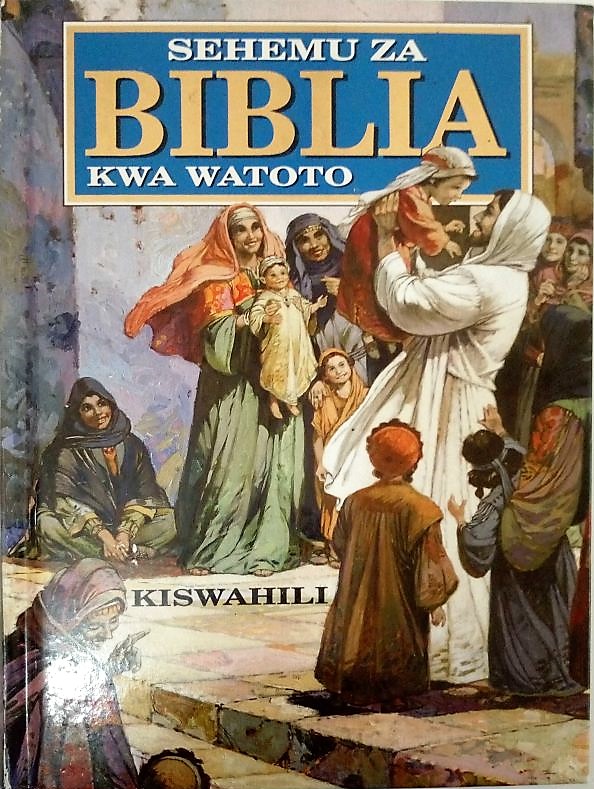Description
Swahili Children's Bible / Sehemu za Biblia kwa Watoto (063P) / Biblia za Watoto
Author: Anne de Graaf
Illustrator: José Pérez Montero
Publisher: Scandinavian Publishing House, 1999
Format: Hardcover
Pages: 408
ISBN-10: 9966409556
ISBN-13: 978-9966409553
Overview
Sehemu za Biblia kwa Watoto offers a delightful journey through the Bible in Kiswahili, specifically designed for young readers. This beautifully illustrated book presents key Bible stories in a way that is both engaging and accessible for children, making it a valuable resource for families and educators aiming to nurture faith from an early age. With its clear language and vivid artwork, the book helps bring biblical narratives to life, encouraging children to explore their spirituality and understand foundational Christian teachings.
Product Features
-
Engaging Illustrations: Illustrated by award-winning artist José Pérez Montero, the book captivates young readers with colorful and vibrant images that reflect each story’s essence. Montero's artwork has earned acclaim worldwide and adds a unique visual dimension to these cherished Bible tales.
-
Expert Authorship: Written by Anne de Graaf, a highly regarded author who has penned over eighty books and sold more than four million copies globally, this Bible is crafted with storytelling expertise that resonates with children. Anne de Graaf’s contributions to Christian literature have won her numerous awards, and her experience brings authenticity and heart to each story.
-
Kid-Friendly Format: The hardcover edition is durable and designed to endure frequent handling, making it ideal for family reading time or use in Sunday schools.
-
Multicultural Appeal: With its Swahili text, this Bible helps children in East Africa and beyond connect with their faith in their native language, enriching their cultural and spiritual understanding.
About the Author and Illustrator
Anne de Graaf is an accomplished children's author, journalist, and translator whose works include over eighty books translated into more than forty languages. Known for her dedication to Christian storytelling, Anne has also been awarded for her contributions to literature, including the Christy Award for Out of the Red Shadow.
José Pérez Montero is a distinguished illustrator whose career spans over thirty years. His rich illustrations have brought countless children’s books to life, with works showcased internationally. Montero’s artwork, recognized for its detail and warmth, has been published in over forty countries.
Audience
Perfect for young readers, families, Sunday schools, and Christian educators looking for a Bible that combines storytelling with visual appeal in Kiswahili. This Bible is especially suitable for East African communities and those who appreciate cultural representation in religious literature.
Hashtags
#SwahiliChildrensBible #BibleForKids #KiswahiliBiblia #AnneDeGraaf #JosePerezMontero #ChildrensIllustratedBible #ChristianLiterature #EastAfricaFaith

Swahili, also known as Kiswahili (translation: coast language), is a Bantu language and the first language of the Swahili people. It is a lingua franca of the African Great Lakes region and other parts of eastern and south-eastern Africa, including Tanzania, Kenya, Uganda, Rwanda, Burundi, Mozambique, and the Democratic Republic of the Congo (DRC). Comorian, spoken in the Comoros Islands is sometimes considered to be a dialect of Swahili, though other authorities consider it a distinct language.
This Book contains bible sections with great illustration from Gensis to Revelation in Kiswahili. It is a perfect tool for children learning Kiswahili and doing bible study. The Swahili language or Kiswahili is a Bantu language and the mother tongue of the Swahili people. It is spoken by various communities inhabiting the African Great Lakes region and other parts of Southeast Africa, including Tanzania, Kenya, Uganda, Rwanda, Burundi, Mozambique and the Democratic Republic of Congo. The closely related Comorian language, sometimes (and incorrectly) considered a Swahili dialect, is spoken in the Comoros Islands. Although only around five million people speak Swahili as their mother tongue, it is used as a lingua franca in much of Southeast Africa. The total number of Swahili speakers exceeds 140 million. Swahili serves as a national or official language of four nations: Tanzania, Kenya, Uganda and the Democratic Republic of the Congo. It is also one of the official languages of the African Union. Some Swahili vocabulary is derived from Arabic through contact with Arabic-speaking Muslim inhabitants of the Swahili Coast. It has also incorporated German, Portuguese, English, Hindi and French words into its vocabulary through contact with empire builders, traders and slavers.

















